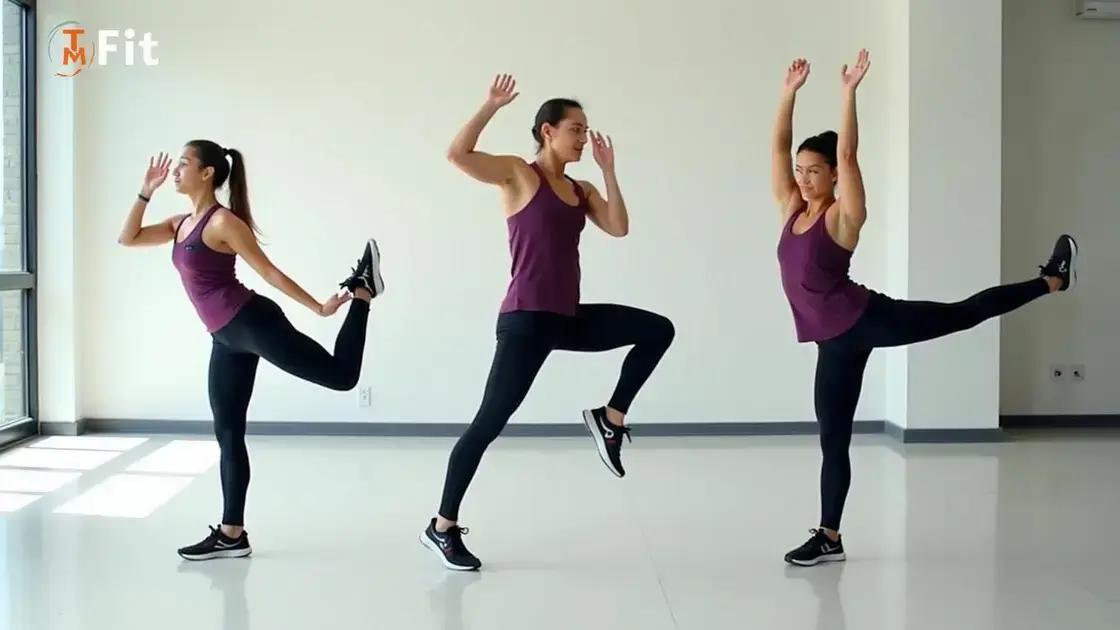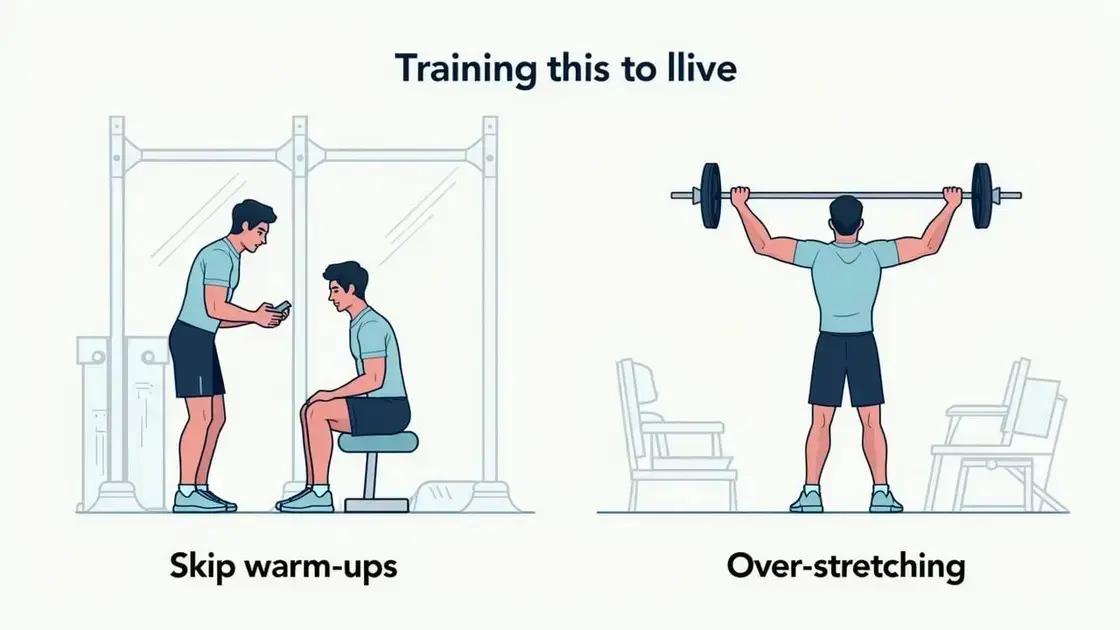To stay flexible while gaining strength, incorporate effective stretching routines, avoid common mistakes like neglecting warm-ups, and prioritize consistency in your training. Combining flexibility and strength supports better performance, reduces injury risk, and promotes faster recovery.
Improving flexibility while gaining strength is a vital goal for many fitness enthusiasts. It enhances performance, reduces injury risk, and aids in recovery. In this article, we delve into effective strategies to balance both aspects of fitness. By the end of this post, you’ll learn techniques that help keep you limber without sacrificing your strength gains.
The Importance of Flexibility in Strength Training

Flexibility is crucial in strength training. Many people believe that lifting heavy weights is the only way to build muscle, but flexibility plays a significant role in overall strength development. When you are flexible, you can move through a larger range of motion during exercises, which can lead to better performance and results.
Benefits of Flexibility in Strength Training
Improved flexibility enhances your workout effectiveness. When your muscles and joints are flexible, you can perform exercises more efficiently. It increases muscle elasticity, allowing for better movement patterns and reducing the risk of injury. Reduced muscle tightness and tension help in quicker recovery times after workouts.
The Connection Between Flexibility and Strength
There is a strong connection between flexibility and strength. When your muscles are flexible, they can generate more force. A flexible muscle can stretch and contract effectively, maximizing strength output. Flexibility also improves coordination and balance, which are essential for executing strength-training exercises safely.
Key Points to Remember
- Flexibility reduces the risk of injuries during workouts.
- Greater range of motion leads to better strength training outcomes.
- Flexibility enhances muscle recovery after intense workouts.
- Incorporating flexibility practices can lead to improved overall fitness.
Incorporating flexibility training into your routine will not only help you build strength but also enhance your overall athletic performance. This combination is key to achieving your fitness goals.
Effective Stretches for Strength Builders

Effective stretches are essential for strength builders. They not only improve flexibility but also prepare your muscles for intense workouts. Here are some key stretches that can enhance your strength-building efforts:
1. Dynamic Warm-Up Stretches
Before lifting weights, it’s important to warm up your body. Leg swings help activate your hip muscles. Stand next to a wall for balance, and swing one leg forward and backward. Do this for 10-15 swings on each leg.
2. Hip Openers
Hip flexibility contributes to better squats and deadlifts. Try the standing quad stretch. Stand on one leg, pull the other heel towards your buttock, and hold for 15-30 seconds while balancing. This stretch targets your quadriceps and hip flexors.
3. Upper Body Stretches
For upper body flexibility, the thoracic spine rotation is beneficial. Sit on the floor with your legs crossed. Place your right hand on your left knee, and gently twist your upper body to the left, holding for 15 seconds. Repeat on the other side.
4. Hamstring Stretches
Strong hamstrings support various lifts. The seated hamstring stretch is effective. Sit on the floor with one leg extended and the other leg bent. Reach for your toes on the extended leg, holding for 15-30 seconds, then switch sides.
5. Incorporating Mobility Drills
Include mobility drills like hip circles. Stand on one leg and make circular movements with the other hip. This improves range of motion and prepares your body for lifting.
6. Post-Workout Stretches
After your workout, it’s important to stretch your major muscle groups. Focus on your back, chest, and legs. The child’s pose is a great way to relax your back after an intense session. Kneel on the ground, sit back on your heels, and stretch your arms forward on the floor.
Incorporating these effective stretches into your routine can lead to greater flexibility, improved performance, and enhanced strength-building results.
How to Incorporate Flexibility into Your Routine

To successfully incorporate flexibility into your routine, follow these practical steps:
1. Allocate Time for Stretching
Set aside time at the start and end of your workouts for stretching. Aim for at least 10-15 minutes. This will ensure your muscles remain flexible.
2. Mix Flexibility with Strength Training
Combine flexibility exercises with your strength training routines. For example, perform dynamic stretches before each workout session. This primes your muscles for strength-building activities while enhancing flexibility.
3. Try Yoga or Pilates
Incorporate yoga or Pilates into your weekly schedule. These practices are excellent for developing both flexibility and strength. Aim for one class each week to experience the benefits.
4. Use Foam Rollers
Foam rolling helps improve flexibility by releasing muscle tension. Spend a few minutes using a foam roller on major muscle groups after your workouts.
5. Focus on Muscle Groups
Pay attention to any areas that feel particularly stiff, such as your hips or back. Prioritize stretches for these muscle groups to enhance flexibility over time.
6. Set Flexibility Goals
Establish specific goals for flexibility. For example, aim to touch your toes or achieve a deeper squat. Tracking progress can motivate you to stay consistent.
7. Be Consistent
Make flexibility training a regular part of your routine. Consistency is key when it comes to improving flexibility.
Integrating these practices into your routine will help increase your flexibility, supporting your strength gains while reducing the risk of injury.
Common Mistakes When Combining Flexibility and Strength

When trying to combine flexibility and strength training, it’s important to avoid common mistakes that can hinder your progress. Here are some key pitfalls to watch for:
1. Neglecting Warm-ups
Many people skip warming up before workouts. This can lead to injuries and decreased performance in both flexibility and strength. Always include a proper warm-up routine that incorporates dynamic stretches.
2. Overstretching
Pushing yourself too far can cause injuries. Always listen to your body and avoid overstretching. Focus on gradual improvements to your flexibility without forcing limits. This helps strike a better balance between flexibility and strength.
3. Ignoring Recovery
Recovery is essential for progress. Skipping rest days or not allowing muscle recovery can lead to fatigue. This may cause poor performance during strength training and hinder flexibility gains. Make sure to incorporate recovery time into your routine.
4. Inconsistent Practice
Flexibility training requires consistency. Many people practice stretches for a short time and expect drastic results. To improve both strength and flexibility, make it a habit to include stretching in your daily routine.
5. Focusing Solely on Strength
Some individuals concentrate only on strength exercises and neglect flexibility altogether. This can result in tight muscles and a limited range of motion. To avoid this, integrate flexibility training with strength workouts.
6. Misunderstanding the Relationship
Many people think flexibility and strength are separate. In reality, they complement each other. Understanding their relationship will help you realize that achieving flexibility improves strength results, and vice versa.
Recognizing and avoiding these common mistakes will foster a better balance between strength and flexibility, leading to improved overall fitness.
In Conclusion: Balancing Flexibility and Strength
Incorporating flexibility into your strength training routine is essential for overall fitness and performance. By understanding the importance of flexibility, applying effective stretches, and avoiding common mistakes, you can achieve optimal results.
Making flexibility a regular part of your workouts will not only enhance your strength but also reduce the risk of injuries and improve recovery times. As you work toward your fitness goals, remember that flexibility and strength go hand in hand, and finding the right balance will lead to a healthier and more effective training regimen.
Stay committed to learning and adapting your routine to embrace both aspects, and you will surely see significant improvements in your physical capabilities.
FAQ – Frequently Asked Questions About Flexibility and Strength Training
Why is flexibility important in strength training?
Flexibility improves your range of motion, enhances strength performance, reduces injury risk, and helps in muscle recovery.
What are some effective stretches for building strength?
Dynamic warm-up stretches, hip openers, upper body stretches, and hamstring stretches are effective for preparing your body for strength training.
How can I incorporate flexibility into my workout routine?
Allocate specific time for stretching, mix flexibility exercises with strength training, try yoga or Pilates, and be consistent.
What are common mistakes when combining flexibility and strength?
Neglecting warm-ups, overstretching, ignoring recovery, inconsistent practice, and misunderstanding the relationship between flexibility and strength.
How often should I work on my flexibility?
Incorporate flexibility training into your routine at least 2-3 times a week for optimal results.
Can flexibility training improve my strength gains?
Yes, improved flexibility allows for better movement mechanics, which in turn can enhance strength gains and performance.












